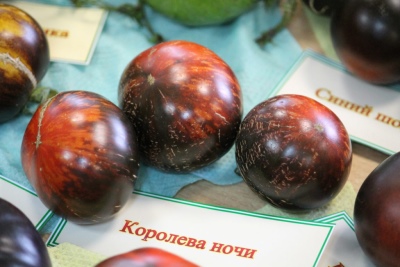
- Authors: Germany
- Name synonyms: Koenigin der Nacht, Queen of the Night
- Category: grade
- Growth type: determinant
- Appointment: fresh consumption
- Ripening period: mid-early
- Ripening time, days: 110-120
- Growing conditions: for open ground, for film greenhouses
- Bush size: undersized
- Bush height, cm: 70
The Queen of the Night is a tomato variety bred by German breeders. Its other names are Koenigin der Nacht, Queen of the Night. The variety quickly fell in love with Russian summer residents for being picky about difficult growing conditions and excellent taste.
Description of the variety
The plant is a short, compact bush about 70 cm high. In greenhouse conditions, it can reach a length of more than a meter. The leaves are dark green. The flower cluster is simple, in each of them 5–6 tomatoes are formed.
The main qualities of the fruit
Unripe tomatoes are almost black in color, ripe fruits are covered with orange-red skin with mottled anthocyanins and shoulders of dark purple tones. For this unusual color, the variety received such an original name.
Tomatoes are medium in size, weighing 60–180 g, rounded in shape, slightly flat. Inside there is a red-raspberry pulp. The only drawback of the fruits is that they are not kept for long enough.
Taste characteristics
The Queen of the Night tomatoes are sweet to taste, the pulp is juicy and fleshy. Mostly they are eaten fresh, the taste of tomatoes is especially bright in a salad with fresh leaves. Also, tomatoes will perfectly complement any national dishes. They are rarely used for canning.
Ripening and fruiting
The Queen of the Night is a medium-early ripening variety, the first tomatoes can be removed 110–120 days after the first shoots appear. Fruiting in tomatoes is long, the crop can be harvested until frost.
Yield
This is a fairly productive variety, capable of producing 9–12 kg of tomatoes from 1 m 2.
The timing of planting seedlings and planting in the ground
This is not a hybrid variety, which means that you can collect your own seeds from ripe fruits and use them for seedlings. Planting dates are usually chosen by the gardener himself, depending on the climatic conditions where the crop will be grown, but, as a rule, sowing is usually done 60-65 days before transplanting into open ground. The planting process looks standard: sowing seeds in a container, picking when the first leaves appear, maintaining soil moisture, hardening seedlings a week before transplanting.

Growing tomato seedlings is an extremely important process, because it largely depends on whether the gardener can harvest at all. All aspects must be taken into account, from seedbed preparation to planting in the ground.
Landing scheme
You can grow tomatoes Queen of the Night both in greenhouses and in the open field, but be prepared for the fact that in the fresh air the fruits will be darker in color. This transformation will not affect the taste in any way. It is required to plant sprouts according to the scheme of 3-4 plants per 1m 2.

Growing and caring
When growing crops, compulsory pinching and shaping are required; it is better to lead in 2-3 stems. This variety tolerates heat and other unfavorable and even extreme conditions well, however, to increase the yield, it is still worth maintaining comfortable growing conditions. So, do not forget about feeding and stick to the fertilization scheme.
- When planting in the ground. The first dressings are added before planting seedlings on the site. The soil must be diluted with organic and mineral compounds.
- 2 weeks after planting. During this period, substances are needed for growth and development. Top dressing should contain nitrogen, phosphorus, potassium, trace elements.
- During the growth period. For proper development of tomatoes at this stage, feed the crop with nitrogen and phosphorus.
- During flowering. Use potassium and phosphorus mixtures and avoid nitrogen-containing fertilizers to keep the power of the plant at fruit setting.
- During fruiting. Potassium, boron, manganese, iodine can be used to improve the taste properties of tomatoes and their accelerated ripening. These substances will add sugariness to the fruit.
- A couple of weeks before harvesting, all feeding must be stopped.




A plant needs different micronutrients at each stage of growth. All fertilizers can be divided into two groups: mineral and organic. Folk remedies are often used: iodine, yeast, bird droppings, eggshells.
It is important to observe the rate and period of feeding. This also applies to folk remedies and organic fertilizers.
Disease and pest resistance
The variety has a high immunity to diseases. Even cracking of the fruit is extremely rare.



























































































